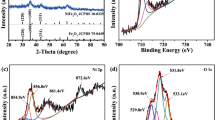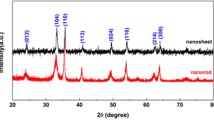Abstract
Through a two-step hydrothermal method, we synthesized a metal-oxide heterostructure composed of SnO2 nanocrystals (NCs) with a diameter of ~ 6 nm and Fe2O3 nanorods (NRs) with a length of ~ 200 nm and a width of ~ 9 nm. The SnO2 NCs are well dispersed on the surface of Fe2O3 NRs. The effect of Fe2O3 NRs loading amount on the electrochemical performance of nanocomposite is investigated. The nanocomposites with less loading amount of Fe2O3 exhibit better electrochemical performance. The enhanced performance is attributed to the synergistic effect of two components. On one hand, the conversion reaction of SnO2 is facilitated due to the presence of Fe2O3 NRs, resulting in a high capacity. On the other hand, Fe2O3 NRs improve the stability of electrode, promoting the cycling performance. The high loading amount of Fe2O3 NRs renders the aggregation of electrode materials, resulting in poor electrochemical performance. Our results demonstrate that adjusting the loading amount of metal oxides in hybrid structures is an effective strategy to enhance lithium storage capacity.







Similar content being viewed by others
References
Tarascon JM, Armand M (2001) Issues and challenges facing rechargeable lithium batteries. Nature 414(6861):359–367
Yoshino A (2012) The birth of the lithium-ion battery. Angew Chem Int Ed 51(24):5798–5800
Chen YM, Yu L, Lou XW (2016) Hierarchical tubular structures composed of Co3O4 hollow nanoparticles and carbon nanotubes for lithium storage. Angew Chem Int Ed 55(20):5990–5993
Goodenough JB, Kim Y (2010) Challenges for rechargeable Li batteries. Chem Mater 22(3):587–603
Liu B, Cao MH, Zhao XY, Tian Y, Hu CW (2013) Facile synthesis of ultrafine carbon-coated SnO2 nanoparticles for high-performance reversible lithium storage. J Power Sources 243:54–59
Reddy MV, Subba Rao GV, Chowdari BVR (2013) Metal oxides and oxysalts as anode materials for Li ion batteries. Chem Rev 113(7):5364–5457
Wang ZY, Zhou L, Lou XW (2012) Metal oxide hollow nanostructures for lithium-ion batteries. Adv Mater 24(14):1903–1911
Chen JS, Archer LA, Lou XW (2011) SnO2 hollow structures and TiO2 nanosheets for lithium-ion batteries. J Mater Chem 21(27):9912–9924
Ao X, Jiang JJ, Ruan YJ, Li ZS, Zhang Y, Sun JW, Wang CD (2017) Honeycomb-inspired design of ultrafine SnO2@C nanospheres embedded in carbon film as anode materials for high performance lithium- and sodium-ion battery. J Power Sources 359:340–348
Pan D, Wan N, Ren Y, Zhang WF, Lu X, Wang YS, Hu YS, Bai Y (2017) Enhanced structural and electrochemical stability of self-similar rice-shaped SnO2 nanoparticles. ACS Appl Mater Interfaces 9(11):9747–9755
Han S, Jang B, Kim T, Oh SM, Hyeon T (2005) Simple synthesis of hollow tin dioxide microspheres and their application to lithium-ion battery anodes. Adv Funct Mater 15(11):1845–1850
Reddy MV, Yu T, Sow CH, Shen ZX, Lim CT, Subbarao GV, Chowdari BVR (2007) α-Fe2O3 nanoflakes as an anode material for Li-ion batteries. Adv Funct Mater 17(15):2792–2799
Jiang TC, Bu FX, Feng XX, Shakir I, Hao GL, Xu YX (2017) Porous Fe2O3 nanoframeworks encapsulated within three-dimensional graphene as high-performance flexible anode for lithium-ion battery. ACS Nano 11(5):5140–5147
Wang B, Chen JS, Wu HB, Wang Z, Lou XW (2011) Quasiemulsion-templated formation of α-Fe2O3 hollow spheres with enhanced lithium storage properties. J Am Chem Soc 133(43):17146–17148
Li JX, Zhao Y, Wang N, Guan LH (2011) A high performance carrier for SnO2 nanoparticles used in lithium ion battery. Chem Commun 47(18):5238–5240
Yin XM, Li CC, Zhang M, Hao QY, Liu S, Chen LB, Wang TH (2010) One-step synthesis of hierarchical SnO2 hollow nanostructures via self-assembly for high power lithium ion batteries. J Phys Chem C 114(17):8084–8088
Wu QH, Zhao RF, Zhang X, Li WL, Xu RH, Diao GW, Chen M (2017) Synthesis of flexible Fe3O4/C nanofibers with buffering volume expansion performance and their application in lithium-ion batteries. J Power Sources 359:7–16
Yan Y, Du FH, Shen XP, Ji ZY, Zhou H, Zhu GX (2014) Porous SnO2-Fe2O3 nanocubes with improved electrochemical performance for lithium ion batteries. Dalton Trans 43(46):17544–17550
Li HQ, Zhou HS (2012) Enhancing the performances of Li-ion batteries by carbon-coating: present and future. Chem Commun 48(9):1201–1217
Hu RZ, Ouyang YP, Liang T, Wang H, Liu J, Chen J, Yang CH, Yang LC, Zhu M (2017) Stabilizing the nanostructure of SnO2 anodes by transition metals: a route to achieve high initial coulombic efficiency and stable capacities for lithium storage. Adv Mater 29(13):1605006
Guo JX, Chen L, Wang GJ, Zhang X, Li FF (2014) In situ synthesis of SnO2-Fe2O3@polyaniline and their conversion to SnO2-Fe2O3@C composite as fully reversible anode material for lithium-ion batteries. J Power Sources 246:862–867
Wang YL, Xu JJ, Wu H, Xu M, Peng Z, Zheng GF (2012) Hierarchical SnO2-Fe2O3 heterostructures as lithium-ion battery anodes. J Mater Chem 22(41):21923
Lee K, Shin S, Degen T, Lee W, Yoon YS (2017) In situ analysis of SnO2/Fe2O3/RGO to unravel the structural collapse mechanism and enhanced electrical conductivity for lithium-ion batteries. Nano Energy 32:397–407
Li Y, Yu SL, Yuan TZ, Yan M, Jiang YZ (2015) Rational design of metal oxide nanocomposites anodes for advanced lithium ion batteries. J Power Sources 282:1–8
Wei W, Wang ZH, Liu Z, Liu Y, He L, Chen DZ, Umar A, Guo L, Li JH (2013) Metal oxide hollow nanostructures: fabrication and Li storage performance. J Power Sources 238:376–387
Zhou XS, Wan LJ, Guo YG (2013) Binding SnO2 nanocrystals in nitrogen-doped graphene sheets as anode materials for lithium-ion batteries. Adv Mater 25:152–2157
Etacheri V, Seisenbaeva GA, Caruthers J, Daniel G, Nedelec JM, Kessler Vadim G, Pol Vilas G (2015) Ordered network of interconnected SnO2 nanoparticles for excellent lithium-ion storage. Adv Energy Mater 5(5):1401289
Liu H, Wang GX, Park J, Wang JZ, Liu HK, Zhang C (2009) Electrochemical performance of α-Fe2O3 nanorods as anode material for lithium-ion cells. Electrochim Acta 54(6):1733–1736
Wang X, Xiao Y, Hu CW, Cao MH (2014) A dual strategy for improving lithium storage performance, a case of Fe2O3. Mater Res Bull 59:162–169
Zhou L, Wu HB, Zhu T, Lou XW (2012) Facile preparation of ZnMn2O4 hollow microspheres as high-capacity anodes for lithium-ion batteries. J Mater Chem 22(3):827–829
Sun XL, Si WP, Liu XH, Deng JW, Xi LX, Liu LF, Yan CL, Schmidt OG (2014) Multifunctional Ni/NiO hybrid nanomembranes as anode materials for high-rate Li-ion batteries. Nano Energy 9:168–175
Wang C, Du GH, Stahl K, Huang HX, Zhong YJ, Jiang JZ (2012) Ultrathin SnO2 nanosheets: oriented attachment mechanism, nonstoichiometric defects, and enhanced lithium-ion battery performances. J Phys Chem C 116(6):4000–4011
Jiang BB, He YJ, Li B, Zhao SQ, Wang S, He YB, Lin ZQ (2017) Polymer-templated formation of polydopamine-coated SnO2 nanocrystals: anodes for cyclable lithium-ion batteries. Angew Chem Int Ed 56(7):1869–1872
Zhou WW, Cheng CW, Liu JP, Tay YY, Jiang J, Jia XT, Zhang JX, Gong H, Hng HH, Yu T, Fan HJ (2011) Epitaxial growth of branched α-Fe2O3/SnO2 nano-heterostructures with improved lithium-ion battery performance. Adv Funct Mater 21(13):2439–2445
Li YF, Hu YJ, Jiang H, Hou XY, Li CZ (2013) Phase-segregation induced growth of core-shell α-Fe2O3/SnO2 heterostructures for lithium-ion battery. CrystEngComm 15(34):6715–6721
Zhang X, Chen HX, Xie YP, Guo JX (2014) Ultralong life lithium-ion battery anode with superior high-rate capability and excellent cyclic stability from mesoporous Fe2O3@TiO2 core-shell nanorods. J Mater Chem A 2(11):3912–3918
Funding
We would like to thank the financial support from the National Key Basic Research Development Program of China (Grant No.: 2012CB722705), the National Natural Science Foundation of China (Grant No.: 10974105), the Natural Science Foundation for Outstanding Young Scientist in Shandong Province (Grant no.: JQ201002), and High-end Foreign Experts Recruitment Programs (Grant Nos.: GDW20173500154, GDW20163500110). Y. Q. Wang would also like to thank the financial support from the Top-notch Innovative Talent Program of Qingdao City (Grant No.: 13-CX-08), the Taishan Scholar Program of Shandong Province, Qingdao International Center for Semiconductor Photoelectric Nanomaterials, and Shandong Provincial University Key Laboratory of Optoelectrical Material Physics and Devices.
Author information
Authors and Affiliations
Corresponding authors
Rights and permissions
About this article
Cite this article
Li, T., Xin, T., Ding, Y. et al. SnO2 nanocrystal-Fe2O3 nanorod hybrid structures: an anode material with enhanced lithium storage capacity. J Solid State Electrochem 23, 379–387 (2019). https://doi.org/10.1007/s10008-018-4133-6
Received:
Revised:
Accepted:
Published:
Issue Date:
DOI: https://doi.org/10.1007/s10008-018-4133-6




